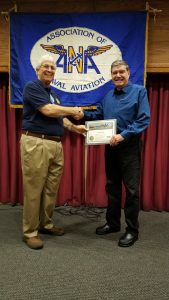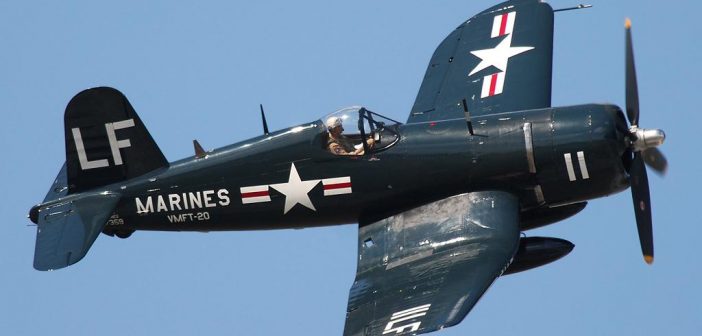 The Grampaw Pettibone Squadron at their May meeting was once again honored to have G. Pat Macha share his knowledge and research of local historic aircraft wrecks and the causes leading up to the crashes.
The Grampaw Pettibone Squadron at their May meeting was once again honored to have G. Pat Macha share his knowledge and research of local historic aircraft wrecks and the causes leading up to the crashes.
For those unfamiliar with Pat, he became involved with aircraft crash site investigation beginning in 1963 as a teenager, while working as a hike master in a youth camp in the San Bernardino Mountains.
While leading an overnight hike, his group came upon an accident crash site containing what Pat recognized as a C-47 (DC-3). Pat’s love of everything airplane comes from his father and interest in finding out why the accident occurred.
Pat shared his knowledge and experience investigating aircraft accident sites in Orange County, a county that is the 48th largest in California, with a little over 3,000,000 inhabitants and once the home to 18 airports or landing sites. Today, the county has only three active fields: John Wayne/Santa Ana, Los Alamitos Joint Forces Base and Fullerton Executive. A few of the former sites included: Marine Corps Air Station El Toro, Marine Corps Air Station Tustin, Mile Square Field and Meadowlark Airport, Huntington Beach.
On June 27th 1943, on a Sunday afternoon, an Army Air Force P-38 departed Santa Ana Army Airfield. The aircraft experienced an engine failure in one engine over Huntington Beach. The pilot, Flight Officer Eugene R. Fair, pointed the aircraft out to sea and bailed out. The torque from the remaining operational engine turned the aircraft back over the beach, crashed and exploded where it injured 50 and killed four children. During WWII there were 52 P-38 accidents within Orange County.
In 2016 relatives of those involved in the crash created a memorial marker for the four children and requested approval from the city of Huntington Beach to place the marker at the accident site. The city did not approve placement and a temporary placement on private property was established with the hope the city will approve movement to a more permanent public location.
The second event that Pat described involved a Marine F4U, Corsair aircraft and a Lockheed P-38, Lightning in a mid-air accident off-shore. Pat displayed pictures that identified parts from both aircraft that are still located in the waters off the coast. Additional photos of TBMs, Dauntless Dive Bombers and Corsairs were displayed and taken while diving in the off-shore waters.
Displaying photos of an F6F-5N, Hellcat wreck site in the local mountains according to Pat is still a mystery. The accident site information does not clearly display a bureau number to confirm the identity of the aircraft in order to confirm the circumstances surrounding the events of the accident.
A photo was shown of an F4U-1, Corsair that crashed on Irvine Ranch land sometime in WWII. Navy records are released with knowledge of the pilot’s name not a crash date, therefore, many accident sites do not have supporting records unless details of the flight are known.
Evidence of crash sites involving fabric covered aircraft result in the remains of metal framing or engine parts. Multiple accident sites of an L-5 aircraft, display airframe and engine parts identified in photos.
During a search on an accident site of a C-47, transport, a friend of Pat’s noted that the remains of a P-47 fighter was no more than 300 feet from the first location. The undergrowth hid the remains, but disclosure of the site enabled Pat to locate the aircraft. Unauthorized searchers took parts of the P-47 and used portable smelters for commercial purposes and destroyed the accident site. This resulted in only a few parts remaining for investigation
Pat described the economic growth of the Orange County area after the war and the development of the Naval Weapons Station at Seal Beach, which replaced a historic airport from the area, the Seal Beach Airport.
The family of the surviving pilot involved in a mid-air while flying an F4U, Corsair, contacted Pat. They requested permission to visit the accident site and with Pat’s access were able to do so. Pat’s involvement with Project Remembrance enables family members the ability to visit accident sites and with permission from property owners or the government to place memorial markers at the location.
An accident site brought to Pat’s attention contained the remains of a Fairchild, PT-19, a WWII trainer. However, there were no records to indicate the origin of the plane, the pilot’s name or cause of the accident.
A Marine Corps ace, Captain Wilbur “Jack” (aka Gus) Thomas was ferrying an F7F, Tiger Cat with one passenger on-board in January 1947. The plane departed from Naval Air Station North Island near San Diego en-route to El Toro Marine Corps Air Station. The weather was stormy and overcast and the plane collided with Santiago Peak east of El Toro, killing both the pilot and passenger onboard. A request to locate and place a remembrance flag at the crash site was carried out by Pat.
Nearby the F7F crash site about 400 yards away are the remains of an aircraft flown by Frank Tallman, famous Hollywood stunt pilot. During a visual flight rules ferry flight of a twin engine Piper Aztec in April 1978, the weather began to deteriorate. The pilot continued to descend looking for clear weather and collided with a ridge in the same general area as the F7F crash site.
Pat related an event that occurred during a training flight by a local police agency. The pilot noticed metal debris when departing the training area. He marked the location and notified Pat who then hiked into the area. Parts were located and the aircraft confirmation was made indicating it was an F3D, Skyknight, a Marine night fighter.
Other accident sites were visited based on known military and civilian records. Sites such as an Air Force C-47 that crashed during a flight from March Field to Long Beach Airport in December 1961; a Navy T2V-1/T-1A Seastar, based on the Lockheed T-33 that crashed shortly after take-off from El Toro in May one year; and in September, 1975 a Marine C-131 with 6 on-board took off from El Toro. In an effort to depart before the noise curfew was active, the plane departed before a full pre-flight was conducted. According to Pat, the accident was the result of sabotage, when it was discovered controls were jammed with tools inside the aircraft.
A portion of the program was devoted to a local airport previously closed in 1989. Meadowlark Airport, the little airport that “was”, as described by Pat. A host of photos displayed a variety of aircraft that had accidents landing as well as taking off from the 2000 foot long airstrip.
The last portion of Pat’s presentation was on Project Remembrance. Project Remembrance is a volunteer organization dedicated to facilitate requests of next of kin who wish to learn more about the loss of loved ones in aircraft accidents, including visitations to known crash sites and placement of memorial plaques when allowed to do so.
One of the Project Remembrance projects was for the worst aviation disaster in Orange County history. This was the Loma Ridge Disaster on June 25, 1965. A USAF C-135, landed at El Toro with a crew of 12 Air Force personnel and scheduled to pick up 72 Marines going to Vietnam. The aircraft model required water injection to aid in engine thrust during take-off. The plane did not have any available water onboard when it arrived and the pilot chose to depart as scheduled. The aircraft could, if needed, take off without the water injection. Weather conditions were fog and drizzle at the scheduled 1:45 am departure. The pilot unfamiliar with the field departed but instead of turning left as required flew straight ahead and struck a ridge near the field, destroying the aircraft, killing all onboard.
Pat received a request from family members of the Marines who were on-board to visit the site. Pat contacted authorities to request approval for the visit, which was initially denied. After Pat contacted a former county official, approval was granted for 44 family members to visit the site. As part of an effort to memorialize the lost servicemen, Pat contacted a local area Boy Scout and suggested an Eagle Scout project. The scout, Jordan Fourcher, and his father created a kiosk that is interactive and is displayed in a public location at the Great Park (formerly El Toro Marine Corps Air Station). A dedication ceremony at the Great Park inaugurated the plaque and kiosk. The ceremony was accompanied by a Missing Man Fly Over.
In closing, Pat referenced a series of books he authored that contains his records of his research and evidence of aircraft accident sites in counties throughout Southern California.




